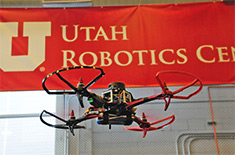Congratulations to Prof. Tommaso Lenzi for receiving new $972K DoD CDMRP grant entitled, “Motorized Hip Orthoses to Improve the Gait Ability of Transfemoral Amputees”. The goal of the project is to validate a new approach to improving amputees’ mobility—providing bilateral hip assistance with a motorized orthosis. Hip orthoses are very lightweight, and their mass is located close to the body center of mass, thus minimizing the metabolic energy cost of carrying this additional weight. In addition, as the orthosis is not suspended through the socket interface, it does not affect balance or socket stability. Because motorized hip orthoses can be...
Read MoreProf. Hermans receives new NSF CRII award for $175,000, project entitled, “CRII: RI: Enabling Manipulation of Object Collections via Self-Supervised Robot Learning”
Congratulations to robotics faculty Prof. Hermans for receiving new NSF CRII award for $175,000. The project is titled, “CRII: RI: Enabling Manipulation of Object Collections via Self-Supervised Robot Learning” Project ABSTRACT: While manipulation of individual objects in cluttered, real-world settings has received substantial attention, the problem of directly manipulating collections of objects has been left unexplored. This project investigates to what extent robots can autonomously manipulate such object collections. This project facilitates autonomous manipulation methods suitable for use in home robotic assistants. Such assistive robots stand to make a substantial impact in increasing the quality of life of older adults...
Read MoreProf. Jake Abbott receives new $385k NIH grant for telerobotic eye surgery
Project title: Quantifying the Benefits of Head-mounting in Telemanipulated Robotic Eye Therapies Many of the up-and-coming therapeutic protocols in ophthalmology are technically difficult, near or beyond the limits of human ability, and are being attempted by only a few surgeons. Surgeon hand tremor combined with patient movement due to breathing and snoring place a lower limit on achievable precision. Over the past few years, with the support of Intuitive Surgical, Abbott and his collaborators have developed a robotic manipulator that is more precise than all prior systems designed for robot-assisted eye surgery, and which is small and light enough...
Read MoreProf. Mark Minor receives new $1.75M NSF grant for smart helmets
Project title: Reducing Traumatic Brain Injury Risk with Smart Collision Detection and Mitigation The goal of the project is to reduce the risk of Traumatic Brain Injury (TBI) through smart technology that collects sensory data to predict and characterize impacts in real-time, optimizes protective mechanisms based on impact characteristics (e.g., direction, velocity), and transmits final impact attributes to a database for further analysis and injury risk prediction. This technology will substantially improve TBI prevention and diagnosis in motor vehicle crashes, sports, and industrial accidents. The unique technology will leverage musculoskeletal and biomechanical computational models linking head linear and angular...
Read MoreLeang, Pardyjak, & Nevada NanoTech Receive US Army DOD Grant to Develop Chemical Sensing Aerial Robot
Kam Leang and Eric Pardyjak partnering with company Nevada NanoTech Systems, Inc., receive US Army DOD grant to develop a chemical sensing aerial robot. The two-year $1,000,000 (Utah’s share of $330,000) project, entitled, “STTR Phase II: Autonomous Broad Spectrum Environmental Sentinels“, will focus on developing an autonomous, hover-capable, flying robot with integrated real-time chemical sensing, inter-unit communication and basics swarming capabilities, and the potential for self-powering. The final platform will detect and identify airborne chemicals using an onboard Molecular Property Spectrometer (MPS)—a low-cost, MEMS-based, lab-on-a-chip platform developed with support from DARPA and the DOD. This chip provides multi-mode chemical analysis with...
Read MoreProf. Jake Abbott receives funding for two-handed large-workspace haptic interface
The Utah Robotics Center recently added two 7-degree-of-freedom Quanser HD^2 haptic interfaces to the shared Large Robotics Lab (valued at $191,800). This equipment purchase was made possible with an award from the University of Utah Research Instrumentation Fund, lead by Prof. Jake Abbott, combined with generous academic discounts from Quanser. A haptic interface is a robotic force-feedback human-input device used to interact with virtual environments and teleoperate remote robotic systems. The haptic interface system will support research from robot-assisted retinal microsurgery to robotics for nuclear applications and nuclear facilities. The new equipment will be shared by the Robotics faculty in the Department...
Read MoreProf. Leang and collaborators receive new $3.8M NSF funding to work on electroactive polymer materials for soft robotics
Kam Leang in collaboration with UNLV-led team (Kwang J. Kim and Paul Oh) and other researchers receive new $3.8M NSF funding to work on electroactive polymer materials for soft robotics. Goal and Objectives: This international project addresses a technologically important issues in soft robotics. Soft robotics is an important emerging field in robotics, mechatronics, and automation. Soft robotic components and systems offer new features and advances over conventional robotic devices. This project focuses on the creation of advanced multifunctional artificial muscles (AM) based on new polymer-metal composites which can be used in soft robotic applications. Artificial muscles can be transformative for...
Read MoreProf. Meek receives new NIH grant to work on Quadrupedal Human-Assistive Robotic Platform (Q-HARP)
NRI: Collaborative Research: Quadrupedal Human-Assistive Robotic Platform (Q-HARP) Prof. Meek receives new 3-year $119,523 NIH grant to work on Quadrupedal Human-Assistive Robotic Platform (Q-HARP). Aging of the population has become a long-term trend in the United States. According to The State of Aging and Health in America, the U.S. population aged 65 and older is expected to double during the 25 years following 2007, and there will be 71 million American older adults, accounting for approximately 20% of the U.S. population by 2030. For the health and wellbeing of older adults, a key factor is being physically active. However,...
Read MoreProf. Leang receives NSF grant to work on temporal-spatial control of dual-stage nanopositioning systems
Prof. Leang and collaborators from industry (Molecular Vista, Inc. (MVI)) and Villanova University (Prof. Garrett Clayton) received a new NSF grant ($305,912) from Sensors, Dynamics, & Control program to study new design and control system approaches for the development of advanced nanopositioning systems for nanoscale science and engineering applications. More specifically, the new 3-year NSF collaborative Grant Opportunities for Academic Liaison with Industry (GOALI) research project focuses on new design and control paradigms for dual-stage nanopositioners that consider both spatial and temporal constraints. Emerging dual-stage nanopositioners have the unique ability to achieve both long-range and high-speed operation. However, typical control strategies rely on frequency-based...
Read MoreProf. Abbott receives NSF Collaborative Research: Shepherding Biomedical Microswimmers Using Magnetic Fields
Jake Abbott (PI) receives NSF grant entitled, “Collaborative Research: Shepherding Biomedical Microswimmers Using Magnetic Fields”. Total budget: $230,427, duration: 8/15/2014-8/14/2017. This project is in collaboration with Henry Fu at the University of Nevada, Reno....
Read More







